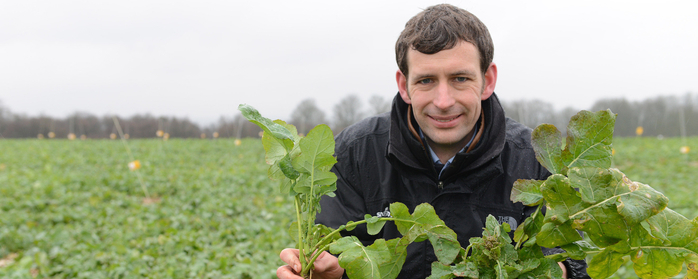Oilseed rape crops held in check into March by the exceptional cold snap will be poised for rapid growth, as soon as conditions warm up. But if the main raceme then shoots away, the yield potential of lower branches could be significantly reduced.
Well timed PGR applications could beneficially hold back the stem extension and enable the side shoots to develop simultaneously – establishing a stronger structure and leaf canopy to produce higher yields, according to Syngenta field technical manager, James Southgate.
“Some of the more advanced crops could be expected to lose leaves in the bitterly cold easterly winds through the end of February and early March, but with well-established root structures they are well placed to recover quickly,” he pointed out.
“To encourage branching and even up the crop they are really going to benefit from an early Toprex application, from early stem extension (GS31).”
Smaller crops, with limited root reserves, however, need nurturing through the coming weeks to increase their green area, when they may then benefit from a later PGR application, from GS51, to develop shape and branching that will make the most of potential light interception, he advocated.
“With the extending day length, plants are poised to take off; as soon as temperatures rise crops will rapidly move through stem extension,” advised Mr Southgate. “Growers should be prepared to apply Toprex at the optimum point to shape canopy development.”
He outlined the objective is to trigger the crop into developing sufficient side shoots to bear seed pods, and the green leaf area to ensure seed fill and increase oil content.
“With a genuine PGR you can shape the crop to improve its overall efficiency. The use of Toprex encourages far greater consistency across the crop, so whilst the onset of flowering on the main raceme may be later, you then get all the side shoots flowering at a similar time – so the flowering is far more intense, but over a shorter period.”
The benefit for the crop is that the yellow flowers physically reflect sunlight, so a shorter duration of flowering means that plant’s green leaves are able to absorb and utilise more energy. It’s particularly evident where the PGR has encouraged stronger side branching and more accessible photosynthetic green leaf.
Mr Southgate added that if some small crops continue to be slow to get going in the spring, or suffered severe pigeon damage, they may be better left without PGR treatment. Ensuring they reach a Green Area Index of 3.5 by the start of flowering should be the priority, he urged.




